J. C. Leyendecker
Joseph Christian Leyendecker (March 23, 1874 – July 25, 1951) was one of the most prominent and financially successful freelance commercial artists in the U.S. He was active between 1895 and 1951 producing drawings and paintings for hundreds of posters, books, advertisements, and magazine covers and stories. He is best known for his 80 covers for Collier's Weekly, 322 covers for The Saturday Evening Post, and advertising illustrations for B. Kuppenheimer men's clothing and Arrow brand shirts and detachable collars. He was one of the few known gay artists working in the early-twentieth century U.S.[1][2][3]
J. C. Leyendecker | |
|---|---|
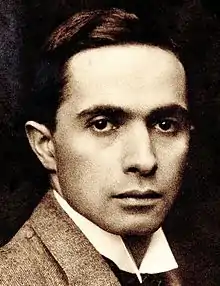 Leyendecker in 1895 | |
| Born | Joseph Christian Leyendecker March 23, 1874 |
| Died | July 25, 1951 (aged 77) New Rochelle, New York, U.S. |
| Nationality | American |
| Education | Chicago Art Institute, Académie Julian |
| Known for | Illustration, painting |
| Partner | Charles Beach |
Early life
Leyendecker (also known as 'J. C.' or 'Joe') was born on March 23, 1874, in Montabaur, Germany, to Peter Leyendecker (1838–1916) and Elizabeth Ortseifen Leyendecker (1845–1905). His brother and fellow illustrator Francis Xavier (aka "Frank") was born two years later. In 1882, the entire Leyendecker family immigrated to Chicago, Illinois, where Elizabeth's brother Adam Ortseifen was vice-president of the McAvoy Brewing Company. A sister, Augusta Mary arrived after the family immigrated to America.[2][3]
As a teenager, around 1890, J. C. Leyendecker apprenticed at the Chicago printing and engraving company J. Manz & Company, eventually working his way up to the position of staff artist. At the same time he took night classes at the school of the Chicago Art Institute.[3]
After studying drawing and anatomy under John Vanderpoel at the Chicago Art Institute, J. C. and Frank enrolled in the Académie Julian[4] in Paris from October 1895 through June 1897. Upon their return to Chicago, the Leyendecker brothers took an apartment in Hyde Park, Illinois. They also shared a studio in Chicago's Fine Arts Building at 410 South Michigan Ave.
Career
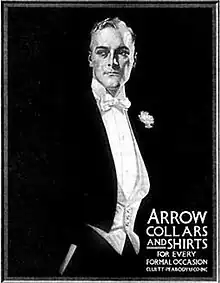
J. C. Leyendecker had a long career that extended from the mid-1890s until his death in 1951. During that time he worked for a wide range of commercial, editorial and government clients.
Before 1902: Chicago and Paris
As a staff artist at J. Manz & Company J. C. Leyendecker produced 60 Bible illustrations for the Powers Brothers Company, cover and interior illustrations for The Interior magazine, and frontispiece art for The Inland Printer. He also produced artwork for posters and book covers for the Chicago publisher E. A. Weeks.[5][6] He also provided artwork for a range of marketing materials for the Chicago men's clothier Hart, Schaffner & Marx.[7]
While in Paris, J. C. Leyendecker continued providing art to Hart, Schaffner & Marx, produced artwork for 12 covers of The Inland Printer, and won a contest (out of 700 entries) for the poster and cover of the midsummer 1896 issue of The Century magazine, which garnered national newspaper and magazine coverage.[1][2][3]
Upon his return from Paris in June 1897, Leyendecker illustrated for a range of mostly local clients including Hart, Schaffner & Marx, the Chicago department store Carson, Pirie & Scott, the Eastern Illinois Railroad, the Northern Pacific Railroad, Woman's Home Companion magazine, the stone cutter's trade journal Stone, Carter's monthly, the bird hobbyist magazine The Osprey, and books including Conan Doyle's Micah Clarke and Octave Thanet's A Book of True Lovers.[1][2] He also painted 132 scenes of America for L. W. Yaggy's laptop panorama of Biblical scenes titled Royal Scroll published by Powers, Fowler & Lewis (Chicago).[8]
On May 20, 1899, Leyendecker received his first commission for a cover for The Saturday Evening Post launching a forty-four-year association with the magazine. Eventually, his work would appear on 322 covers of the magazine, introducing many iconic visual images and traditions including the New Year's Baby, the pudgy red-garbed rendition of Santa Claus, flowers for Mother's Day, and firecrackers on the 4th of July.[1]
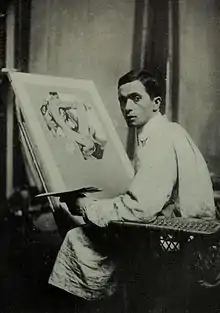
During the 1890s, Leyendecker was active in Chicago's arts community. He exhibited with and attended social events by the Palette and Chisel Club, the Art Students League, and the Chicago Society of Artists. In December 1895, some of his posters were exhibited at the Siegel, Cooper & Company department store in Chicago. In January 1898 his posters for covers of The Inland Printer were exhibited at the Kimball Cafetier (Chicago).[2][9]
During his 1895-97 time studying in Paris, J. C. Leyendecker's work won four awards at the Académie Julian and one of his paintings titled "Portrait of My Brother" was exhibited in the Paris salon in 1897. One of his posters for Hart, Schaffner & Marx titled "The Horse Show" was exhibited as part of the award winning display of American manufacturers' posters at the Exposition Universelle (1900) in Paris.[7]
After 1902: New York City and New Rochelle
After relocating to New York City in 1902, Leyendecker continued illustrating books, magazine covers and interiors, posters, and advertisements for a wide range of ever-larger and more-prominent clients.
His illustrations for men's product advertising, pulp magazines, and college posters earned him a reputation as specialist in illustrations of men.[10] Major clients included the Philadelphia suitmaker A. B. Kirschbaum,[7] Wick Fancy Hat Bands,[11] Gillette Safety Razors,[12] E. Howard & Co. watches, Ivory Soap, Williams Shaving Cream, Karo Corn Syrup, Kingsford's Corn Starch, Interwoven socks, B. Kuppenheimer & Co., Cooper Underwear, and Cluett Peabody & Company, maker of Arrow brand shirts and detachable shirt collars and cuffs.
The male models who appeared in Leyendecker's 1907-30 illustrations for Arrow shirt and collar ads were often referred to as "the" Arrow Collar Man even though they were modeled by a number of different men, some of whom went on to successful careers in theater, film, and television. Some models include Brian Donlevy, Fredric March, Jack Mulhall, Neil Hamilton, Ralph Forbes, and Reed Howes.[13]
One of Leyendecker's most frequently used models was the Canadian-born Charles A. Beach (1881–1954). Leyendecker met Beach in 1903 when Beach came to the artist's New York studio looking for modeling work.[14] Beach subsequently appeared in many of Leyendecker's illustrations and the two enjoyed a nearly 50-year professional and personal relationship. Many Leyendecker biographers have described that relationship as having a romantic and sexual dimension.[4][15][16][17]
Another important Leyendecker client was Kellogg's cereals. As part of a major advertising campaign, he painted a series of twenty different images of children eating Kellogg's Corn Flakes.[18]
During the first World War and Second World War Leyendecker painted military recruitment posters and war bonds posters for the U.S. government.
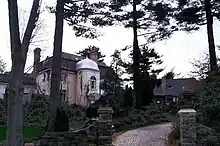
Decline of career
After 1930, Leyendecker's career began to slow, perhaps in reaction to the popularity of his work in the previous decade or as a result of the economic downturn following the Wall Street Crash of 1929.
Around 1930-31, Cluett Peabody & Company ceased using Leyendecker's illustrations in its advertisements for Arrow collars and shirts. In 1936, George Horace Lorimer, the famous editor at the Saturday Evening Post, retired and was replaced by Wesley Winans Stout (1937–1942) and then Ben Hibbs (1942–1962), both of whom rarely commissioned Leyendecker to illustrate covers.[19] Leyendecker's last cover for the Saturday Evening Post was of a New Year Baby for the January 2, 1943, issue.[20]
New commissions were fewer in the 1930s and 1940s. These included posters for the United States Department of War, in which Leyendecker depicted commanding officers of the armed forces encouraging the purchases of bonds to support the nation's efforts in World War II.[19]
Personal life
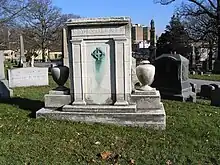
Sexuality
No statements (in Leyendecker's own words) survive concerning his sexual desires, behavior, or identity; however, what is known about his personal life fits the pattern historians have identified for many gay men who lived during his time.[4][16][17][21][22]
Leyendecker never married, and he lived with another man, model Charles A. Beach, for most of his adult life (1903–1951).[14] Beach was Leyendecker's studio manager and frequent model, and many biographers describe Beach as Leyendecker's romantic, sexual, or life partner. They also describe Leyendecker as "gay" or "homosexual."[1][3][4][16][23]
Some historians have attributed the homoeroticism in some of Leyendecker's work to his sexuality while others have pointed to the collaborative nature of commercial art making, which suggests the content of Leyendecker's work was more expressive of the times in which it was created than the artist's sexuality.[12][16][22][24][25]
Residences
In 1915, J. C., his brother Frank and sister Augusta Mary relocated from New York City to a newly built home and art studio in New Rochelle, New York, an art colony and suburb of New York City.[26] Sometime after 1918, Charles Beach also moved into the New Rochelle home.
Leyendecker and Beach reportedly hosted large galas attended by people of consequence from all sectors. The parties they hosted at their New Rochelle home/studio were important social and celebrity making events.[1]
While Beach often organized the famous gala-like social gatherings that Leyendecker was known for in the 1920s, he reportedly (by Norman Rockwell) also contributed largely to Leyendecker's social isolation in his later years. Beach reportedly forbade outside contact with the artist in the last months of his life.[27]
Due to his professional success, Leyendecker enjoyed a luxurious lifestyle with large home, domestic servants, and chauffeured car. However, when commissions began to wane in the 1930s, he was forced to curtail spending considerably. By the time of his death, Leyendecker had let all of the household staff at his New Rochelle estate go, with he and Beach attempting to maintain their home themselves.[1][2][3]
Death, burial, disposition of estate
Leyendecker died on July 25, 1951, of an acute coronary occlusion at his home in New Rochelle. He was buried alongside his parents and brother Frank at Woodlawn Cemetery in The Bronx, New York City.[28]
Leyendecker's will directed his estate—house, furnishings, paintings, etc.—be divided equally between his sister Augusta Mary and Charles Beach. Though Leyendecker directed Beach to burn his drawings upon his death, Beach instead sold many of his drawings and paintings at a lawn sale.[3][14]
Other Leyendecker works were sold through New York's Society of Illustrators or given to the New York Public Library and Metropolitan Museum of Art. Sister Augusta Mary Leyendecker retained many of J. C. Leyendecker's paintings for Kellogg's cereals, and donated them along with other family ephemera upon her death to the Haggin Museum.[1][2]
Body of work
Notable clients

- Amoco
- Boy Scouts of America
- The Century Company
- Chesterfield Cigarettes
- Cluett, Peabody & Company
- Collier's Weekly
- Cooper Underwear
- Cream of Wheat
- Curtis Publishing Company
- Franklin Automobile
- Hart Schaffner & Marx
- Howard Watch
- Ivory Soap
- Karo Corn Syrup
- Kellogg Company
- Kuppenheimer
- Overland Automobile
- Palmolive Soap
- Pierce Arrow Automobile
- Procter & Gamble
- The Timken Company
- Saturday Evening Post
- U.S. Army
- U.S. Marines
- U.S. Navy
- Wick Fancy Hat Bands
- Willys-Overland Company
Museum holdings
Examples of his original artwork can be found in the collections of the Metropolitan Museum of Art (New York City), Norman Rockwell Museum (Stockbridge, MA), Haggin Museum (Stockton, CA), National Museum of American Illustration (Newport, RI), Lucas Museum of Narrative Art (Los Angeles, CA), and Pritzker Military Museum & Library in Chicago, IL. Significant collections of Leyendecker's work as reproduced can be found in many major archives and library collections including the Hagley Museum and Library (Wilmington, DE), Winterthur Museum, Garden and Library (Wilmington, DE), New York Public Library (New York, NY), and the D. B. Dowd Modern Graphic History Library Archives at Washington University in St. Louis (St. Louis, MO).
Legacy
As the premier cover illustrator for the enormously popular Saturday Evening Post for much of the first half of the 20th century, Leyendecker's work both reflected and helped mold many of the visual aspects of the era's culture in America. The mainstream image of Santa Claus as a jolly fat man in a red fur-trimmed coat was popularized by Leyendecker, as was the image of the New Year Baby.[29] The tradition of giving flowers as a gift on Mother's Day was started by Leyendecker's May 30, 1914 Saturday Evening Post cover depicting a young bellhop carrying hyacinths. It was created as a commemoration of President Woodrow Wilson's declaration of Mother's Day as an official holiday that year.
Leyendecker was a chief influence upon, and friend of, Norman Rockwell, who was a pallbearer at Leyendecker's funeral. In particular, the early work of Norman Rockwell for the Saturday Evening Post bears a strong superficial resemblance to that of Leyendecker. While today it is generally accepted that Norman Rockwell established the best-known visual images of Americana, in many cases they are derivative of Leyendecker's work, or reinterpretations of visual themes established by Rockwell's idol.
The visual style of Leyendecker's art inspired the graphics in The Dagger of Amon Ra, a video game, as well as designs in Team Fortress 2, a first-person shooter for the PC, Xbox 360, and PlayStation 3.[30]
Leyendecker's work inspired George Lucas and will be part of the collection of the anticipated Lucas Museum of Narrative Art.[31]
Leyendecker's Beat-up Boy, Football Hero, which appeared on the cover of The Saturday Evening Post on November 21, 1914, sold for $4.12 million on May 7, 2021.[32][33] The previous world record for a J. C. Leyendecker original was set in December 2020, when Sotheby's sold his 1930 work Carousel Ride for $516,100.[34]
Costume designer Carol Cutshall used Leyendecker's illustrations as inspiration for the costumes created for Anne Rice's Interview with the Vampire on AMC, a 2022 television series adaptation of the 1976 novel by American author Anne Rice. Of the clothing designed specifically for the male characters Louis de Pointe du Lac and Lestat de Lioncourt, Cutshall said, in part, "And the whole first two episodes, their style sense in many ways is a love letter to Leyendecker. Some things are just perfectly pulled from – like their formalwear, their tuxedos that they wear to the opera in 1917, and the black pinstripe suit with the green tie and the white boutonniere that Lestat wears to the du Lac family home for dinner – those are from a Leyendecker illustration." Cutshall also referenced Louis and Lestat's clothing being created from Leyendecker's illustrations as a way to draw a parallel between Louis and Lestat, who were shown in the series as having to keep their romantic relationship hidden from the public in the 1910s and 1920s, and Leyendecker and his life partner, Charles Beach.[35]
Films and plays
In Love with the Arrow Collar Man, a play written by Lance Ringel and directed by Chuck Muckle at Theatre 80 St. Marks from November to December 2017, dramatizes the life of Leyendecker and his life partner Charles Beach.
Coded, a 2021 film documentary, tells the story of Leyendecker and premiered at the TriBeCa Film Festival in 2021.[36]
Gallery
 Illustration for Arrow Collar ad, 1907. J. C. Leyendecker
Illustration for Arrow Collar ad, 1907. J. C. Leyendecker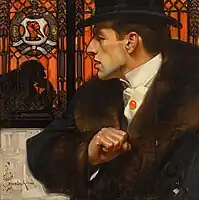 The Sleuth, circa 1906. Cover of the Saturday Evening Post, June 2, 1906
The Sleuth, circa 1906. Cover of the Saturday Evening Post, June 2, 1906 Arrow Shirts ad from the 1920s
Arrow Shirts ad from the 1920s Leyendecker illustration on cover of December 28, 1907, issue of The Saturday Evening Post
Leyendecker illustration on cover of December 28, 1907, issue of The Saturday Evening Post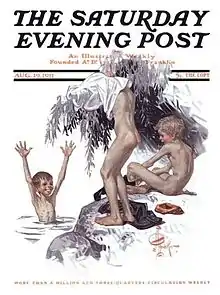 Leyendecker illustration on for August 19, 1911, cover of The Saturday Evening Post
Leyendecker illustration on for August 19, 1911, cover of The Saturday Evening Post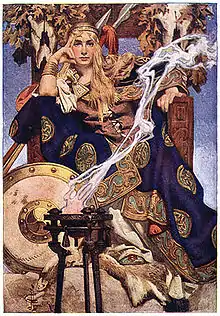 Illustration for Queen Maev in Myths and Legends of the Celtic Race, 1911
Illustration for Queen Maev in Myths and Legends of the Celtic Race, 1911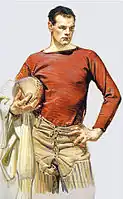 Leyendecker painting ca. 1913. Model is Charles A. Beach
Leyendecker painting ca. 1913. Model is Charles A. Beach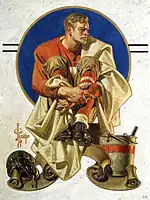 Study for the cover of The Saturday Evening Post
Study for the cover of The Saturday Evening Post.jpg.webp) J. C. Leyendecker painting for U.S. Marines recruiting poster
J. C. Leyendecker painting for U.S. Marines recruiting poster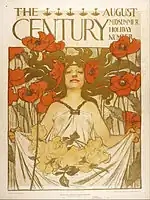 Award-winning Leyendecker illustration on midsummer holiday (August 1896) issue of The Century Magazine
Award-winning Leyendecker illustration on midsummer holiday (August 1896) issue of The Century Magazine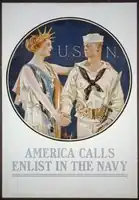 U.S. Navy military recruitment poster
U.S. Navy military recruitment poster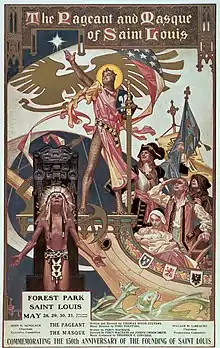 Leyendecker-illustrated poster for The Pageant and Masque of St. Louis, Forest Park, May 28–31, 1914
Leyendecker-illustrated poster for The Pageant and Masque of St. Louis, Forest Park, May 28–31, 1914
See also
References
- Cutler, Laurence S.; Cutler, Judy Goffman (November 2008). J.C. Leyendecker: American Imagist. Harry N. Abrams. ISBN 978-0-8109-9521-5.
- Saunders, David (2021). The Art of J. C. Leyendecker. Decatur, IL: The Illustrators Press.
- Schau, Michael (1974). J.C. Leyendecker. Watson-Guptill Publication. p. 14-15. ISBN 0-8230-2757-0.
- Smith, Patricia Juliana (December 7, 2002). "Leyendecker, Joseph C." (PDF). glbtqarchive.com.
- The Inland Printer. Maclean-Hunter Publishing Corporation. 1895.
- Leyendecker, J. C. (Joseph Christian) (1895). "One fair daughter by Frank Frankfort Moore". www.loc.gov. Retrieved July 14, 2021.
- "Wholesale Clothing Publicity". Printers' Ink. 39 (12): 3–7. June 18, 1902 – via Google Books.
- "Books and Bookmakers". North-western Christian Advocate. 45 (50): 31. December 15, 1897.
- "A Leyendecker Exhibition". Brush and Pencil. 1 (4): 109–110. 1898. ISSN 1932-7080. JSTOR 25505200.
- "A Champion of Mere Man in Art—Artist Leyendecker Supplies Companions for Gibson Girls". New York Sun: 6. July 13, 1913.
- The Illustrated Milliner. Illustrated Milliner Company. 1916.
- Martin, Richard (June 1995). "Gay Blades: Homoerotic Content in J.C. Leyendecker's Gillette Advertising Images". The Journal of American Culture. 18 (2): 75–82. doi:10.1111/j.1542-734x.1995.00075.x. ISSN 1542-7331.
- Turbin, Carole (2002). "Fashioning the Arrow Collar Man". Gender & History. 14 (3): 470–491. doi:10.1111/1468-0424.00278. S2CID 143053525.
- Wallace, Ed (August 25, 1951). "Arrow Collar Man—He Lives in the Shadows". New York Sun. p. 3.
- "Arrow Collar Man Model Dies at 72 - 24 Jun 1954, Thu • Page 26". The Times Record: 26. 1954. Retrieved March 18, 2018.
- Cooper, Emmanuel (1994). The Sexual Perspective: Homosexuality and Art in the Last 100 Years in the West. Routledge. p. 132. ISBN 0-415-11100-5.
- Streitmatter, Rodger (2012). Outlaw Marriages: The Hidden Histories of Fifteen Extraordinary Same-Sex Couples. Boston: Beacon Press. pp. 55–66. ISBN 978-0807003343.
- "J.C. Leyendecker (1874–1951)". Haggin Museum. Archived from the original on June 15, 2019. Retrieved September 9, 2010.
- Meyer, Susan E. "J.C. Leyendecker." In America's Great Illustrators, 136–159. New York: H. N. Abrams, 1978.
- Greenhill, Jennifer A. (December 2018). "How to Make It as a Mainstream Magazine Illustrator; or, J. C. Leyendecker and Norman Rockwell Go to War". Winterthur Portfolio. 52 (4): 209–252. doi:10.1086/703201. ISSN 0084-0416. S2CID 167140679.
- Chauncey, George (April 9, 2019). Gay New York : gender, urban culture, and the making of the gay male world, 1890-1940. Basic Books. ISBN 978-1-5416-9921-2. OCLC 1048447557.
- M., Saslow, James (1999). Pictures and passions: a history of homosexuality in the visual arts. Viking. OCLC 74330998.
{{cite book}}: CS1 maint: multiple names: authors list (link) - Kriss, Gary (December 27, 1998). "The Father of the New Year's Baby". The New York Times. pp. section 14WC, page 1.
- Martin, Richard (October 1996). "J. C. Leyendecker and the Homoerotic Invention of Men's Fashion Icons, 1910–1930". Prospects. 21: 453–470. doi:10.1017/s0361233300006621. ISSN 0361-2333.
- Murphy, Michael J. (November 30, 2022). "Situating J. C. Leyendecker within the Conflicting Narratives of the Gay and Lesbian Past". American Quarterly. 74 (4): 1079–1093. doi:10.1353/aq.2022.0074. ISSN 1080-6490. S2CID 254221730.
- Schau, Michael (1974). J.C. Leyendecker. Watson-Guptill Publication. p. 32. ISBN 0-8230-2757-0.
- Norman Rockwell. My Adventures as an Illustrator.
- Wilson, Scott. Resting Places: The Burial Sites of More Than 14,000 Famous Persons, 3d ed.: 2 (Kindle Location 27882). McFarland & Company, Inc., Publishers. Kindle Edition.
- Segal, Eric Jefferson. "Realizing Whiteness in U.S. Visual Culture: The Popular Illustration of J.C. Leyendecker, Norman Rockwell, and the Saturday Evening Post, 1917–1945." PhD Dissertation, University of California Los Angeles, 2002.
- Francke, Moby. Team Fortress 2 tc_hydro Developer Commentary, node 14.
- "Lakefront campus recommended for George Lucas interactive museum | Early & Often". Politics.suntimes.com. May 19, 2014. Archived from the original on May 20, 2014. Retrieved July 15, 2014.
- "'Football Hero' Scores New World Record". Antique Trader. May 11, 2021. Retrieved May 19, 2021.
- "World Record for Magazine Cover Art by J.C. Leyendecker". Fine Books Magazine. May 10, 2021. Retrieved May 19, 2021.
- "Carousel Ride". Sotheby's. 2020. Retrieved May 19, 2021.
- Marcus, Laura E. (November 8, 2022). "Interview with the Vampire Q&A w Costume Designer Carol Cutshall | AMC Talk | AMC". www.amc.com. Retrieved November 16, 2022.
- "Innovative Stories: Here's The 2021 Tribeca Festival Shorts Lineup". TriBeCa Film Festival. April 22, 2021. Retrieved May 19, 2021.
Further reading
- Carter, Alice A., Judy Francis Zankel, and Terry Brown. Americans Abroad: J. C. Leyendecker and the European Academic Influence on American Illustration. New York: Society of Illustrators, 2008. ISBN 1-60530-843-9 OCLC 237005126
- Cutler, Judy Goffman, and Laurence S. Cutler. Norman Rockwell and His Mentor, J. C. Leyendecker. Newport, R.I. : National Museum of American Illustration, 2010. OCLC 769953338
- Cutler, Judy Goffman, and Laurence S. Cutler. J. C. Leyendecker: American Imagist. New York: Abrams, 2008. ISBN 0-8109-9521-2 OCLC 222664794
- Ermoyan, Arpi. Famous American Illustrators. [Crans, Switzerland]: Published for the Society of Illustrators by Rotovision, 1997. ISBN 2-88046-316-5 OCLC 38530600
- Leyendecker, J. C. An Exhibition of Original Poster Designs ... Under the Auspices of "The Inland Printer"... January 11 to 31, 1898. 1898. OCLC 62871338
- Leyendecker, J. C. The Saturday Evening Post: An Illustrated Weekly Magazine ... December 29, 1906 ... New Year's. Philadelphia: s.n, 1906. OCLC 565522034
- Meyer, Susan E. America's Great Illustrators. New York : H. N. Abrams, 1978. ISBN 0-8109-0663-5 OCLC 3275418
- Moroney, Lindsay Anne. High Art Joins Popular Culture: The Life and Cover Art of J.C. Leyendecker. Thesis (Honors), College of William and Mary, 2004. OCLC 56995122
- Saunders, David. The Art of J. C. Leyendecker. Decatur, IL: The Illustrated Press, 2021.
- Schau, Michael. J. C. Leyendecker. New York: Watson-Guptill Publications, 1974. ISBN 0-8230-2757-0 OCLC 874308
- Steine, Kent and Fred Taraba. The J. C. Leyendecker Collection: American Illustrators Poster Book. Portland, Ore. : Collectors Press, 1996. ISBN 0-9635202-8-8 OCLC 35297768
- The J. C. Leyendecker Poster Book. New York: Watson-Guptill Publications, 1975. ISBN 0-8230-2758-9 OCLC 1583713
External links
- Leyendecker Collection at The National Museum of American Illustration
- Leyendecker biography, with illustrations from JVJ Publishing Archived November 29, 2011, at the Wayback Machine
- J.C. Leyendecker at Open Letters
- Leyendecker Collection at The Haggin Museum
- UNCG American Publishers' Trade Bindings: J.C. Leyendecker
- J. C. Leyendecker at Library of Congress, with 34 library catalog records